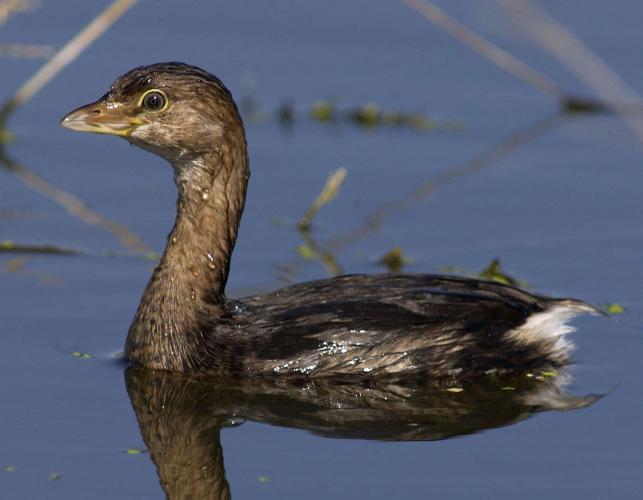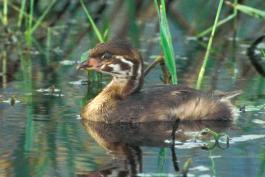
A small brown grebe with a large head and pale bill with a dark ring around the middle in breeding season. In winter, the ring on the bill may be obscured, but the small size and the conical chickenlike bill help with identification. Grebes have unique feet, with flaplike lobes along the toes instead of being webbed like those of ducks. Voice is a loud series: cowk cowk cowk.
Similar species: Western grebes (which are much bigger) and eared grebes are both uncommon or rare in Missouri, and horned grebes are generally uncommon. They all have long, sharp, narrower bills and lack the dark ring on the bill. Grebes can be distinguished from small ducks by their bill shape.
Length: 14 inches (tip of bill to tip of tail).

Statewide.
Habitat and Conservation
Rests and forages on all types of open water, including lakes, rivers, and ponds. In summer, breeds on deepwater marshes, lakes, and ponds rimmed with marsh vegetation. In winter they swim where water remains unfrozen. They frequently dive underwater and commonly float so low in the water that only the head is seen above the surface, like a submarine’s periscope. They are not strong fliers. On land they walk awkwardly. To take off from water, they need a long, running, flapping start.
Food
Forages among aquatic plants, typically diving underwater to forage on crayfish and other crustaceans, plus fish, insects, and other creatures. The short, stout bill helps them crunch the shells of crayfish.
Status
Common transient; uncommon winter resident in the south part of Missouri; uncommon summer resident (breeder) locally. This species is declining in New England and has been declared endangered or threatened by states in that region. Habitat loss seems to be the cause.
Life Cycle
Bowl-shaped nests are built on a platform constructed out of a variety of floating vegetation and are usually hidden among tall, emergent aquatic plants. Clutches comprise up to 10 eggs, which are incubated for 23 to 27 days. When an adult leaves the nest temporarily, it pulls nearby plants over the nest to conceal it. Upon hatching, the down-covered young are active and alert. During their first week, they ride around on their mother’s back.
Human Connections
Before birds’ common names were standardized, grebes were sometimes called “hell-divers,” “devil-divers,” and “water-witches” for their uncanny way of sinking slowly beneath the water’s surface. They are amazingly good swimmers, capable of adjusting their buoyancy at will. They’re fun to watch!
Ecosystem Connections
Although humans don’t hunt them, pied-billed grebes (and their eggs and young) are eaten by many other animals, including fish, frogs, snakes, hawks and eagles, raccoons, minks, and even muskrats. Grebes help control populations of the many aquatic animals they feed upon.
















About 350 species of birds are likely to be seen in Missouri, though nearly 400 have been recorded within our borders. Most people know a bird when they see one — it has feathers, wings, and a bill. Birds are warm-blooded, and most species can fly. Many migrate hundreds or thousands of miles. Birds lay hard-shelled eggs (often in a nest), and the parents care for the young. Many communicate with songs and calls.





















